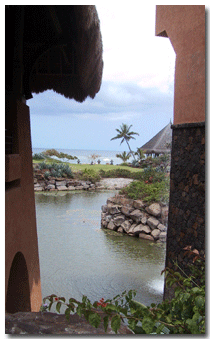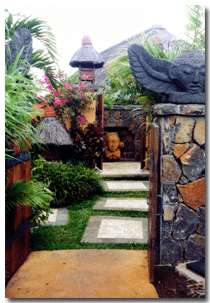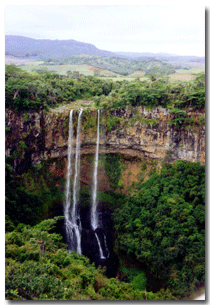Mauritius – Once a French Colony

- SUBSCRIBE
- ALREADY SUBSCRIBED?
BECOME A BONJOUR PARIS MEMBER
Gain full access to our collection of over 5,000 articles and bring the City of Light into your life. Just 60 USD per year.
Find out why you should become a member here.
Sign in
Fill in your credentials below.
 Everybody
Everybodyknows that the best place to buy a baguette is France, and the second
best place is one of her colonial outposts. But have you been to a
former French colony where you can get a really good croissant – and a
really good cup of tea?
small island in the Indian Ocean has such a checkered past that its
ethnic mix is like nowhere else in the world. Once known as Ile de
France, Mauritius remains so Francophile that the preferred language of
everyday conversation is French. However, the island, which gained
independence in 1968, is part of the British Commonwealth. They grow
tea here, and imbibing the brew is a legacy of English occupation.
also has been a Dutch colony and, before that, a stopover for Arab and
Portuguese sailors. In addition, there are the descendants of African
slaves and indentured servants from India. All combine with the
handfuls of European expats to create a nation of 1.2 million that’s
unusually exotic. I was continually startled when dark-eyed women in
brightly colored saris would greet me with a musical bonjour!
island does have one big claim to fame. Remember the dodo bird? This is
where it was driven into extinction – not so much by the European
settlers, but by the housecats they brought with them (what carnivore
could resist pouncing on a bird that didn’t fly away?).
centuries of sailors (and pirates) had made note of the island, it
seems there was no indigenous human population at the time of the Dutch
arrival in 1598. True royalists, they named it for the Prince of
Orange, their own Maurice of Nassau.
island was under the supervision of the Compagnie des Indes from 1715
to 1764. While nearby Ile de Réunion flourished as a coffee plantation,
development on Ile de France languished until the arrival of François
Mahé de la Bourdonnais as governor in 1735. He laid out the town of
Port Louis and created the island’s first sugar estates.
French ceded the island to England in 1810, and sugar production
continued to increase. By 1858, there were 259 factories in operation.
The French had imported slaves from East Africa and Madagascar to work
the sugar plantations they established on Mauritius, but the British
outlawed slavery in the 1830s. They imported their labor in the form of
indentured servants from India until 1909.
Mauritius gained independence in 1968, it remained with the British
Commonwealth. Although English is the official language, most everyday
conversation is in French (albeit with a Creole lilt).
terrific reason to visit Mauritius is the opportunity to step out of
the ordinary. Instead of deadlines and traffic, there’s leisure and
tranquility. The warm breezes carry the scent of flowers. Tropical
birds flit among the palms, and frogs fill the twilight with their
deep-throated croaks.
 The
TheOberoi Mauritius is all about retreating from reality. I was lucky
enough to stay at this luxurious resort on the Baie aux Tortues. Just
three years old, the resort is on the un-touristy northwest corner of
the island. Spread across its 20 acres, there are 76 separate villas –
sort of like guesthouses in a private paradise on the beach. Guests
with a yen for complete seclusion can claim one of the villas with its
own swimming pool enclosed in a walled garden, order room service and
never venture out to mingle with the hoi polloi. I relished sampling
the varied and inventive cuisine drawn from all the cultures of
Mauritius served in its open-air restaurant overlooking the ocean.
fire at a neighboring resort spread to some of the resort’s rooftops
last December, but the damage has been repaired and everything’s back
to normal (although everything at the Oberoi Mauritius remains far
above ordinary).
there, I chose the option of breakfast in my room, or, rather, on my
private patio. The island abounds with brightly colored birds I’d never
seen before, but they’re obviously used to visitors. Each morning, I
had to defend my breadbasket from a couple of red, black and white
feathered would-be thieves.
are everywhere: frangipani, bougainvillea, jacaranda, orchids,
hibiscus, anthurium. Every time I returned to my room, the maid had
rearranged the towels and folded the clothing I’d discarded on the
rattan couch – then carefully placed fresh flower blossoms in the folds.
large marble bathroom, freshly flower-strewn each day, has a sunken tub
and a shower. The tub has a clear glass wall separating it from a
personal garden, but the shower has a separate door so you can step
outside – or back into the bathroom.
you can rouse yourself to leave the resort, expeditions around the
island are many and varied. I enjoyed an afternoon at Pamplemousses
gardens, had lunch barbecued by my captain on a boat trip to a
picturesque cove, drove a bit along the Tea Route, visited a former
sugar plantation and took an underwater trip on a mini submarine.
island is volcanic, so the topography is varied. There are steep jagged
peaks inland with waterfalls plummeting off cliffs into deep rocky
valleys. At Black River Gorge National Park, the resident monkeys
begged treats from visitors. I marveled at the seven-colored earth of
Chamarel – if I could only remember my geology classes I’d know what
caused the colors of the rainbow-hued volcanic dunes.
62 acres of the Jardins de Pamplemousses were first laid out in the
1700s by de la Bourdonnais, who built his house there. Later, Pierre
Poivre, a French noble determined to grow spices on the island, bought
the land. In a quest to figure out what grew best, he collected
specimens for the gardens from around the world: laurel from the
Caribbean, camphor from China, breadroot from the Philippines and
litchi from Indochina.
returned to France, Nicolas Céré, a botanist, continued its
development. These days, the gardens are an outstanding collection of
exotic plants and trees — including a Talipot Palm that flowers just
once every 60 years (but not while I was there).
picked up an inexpensive self-guided tour booklet (in English) when I
entered the Sir Seewoosagur Ramgoolam Botanical Garden (its official
name since 1988), and wandered from spectacular plant to fantastic
tree. Don’t miss the banyans, water lilies or lotus.
 At
AtBois Chéri, a tea plantation and factory that welcomes visitors, I
watched the processing and learned that the locals prefer their tea
scented with vanilla.
du Sucre, a sugar factory no longer in production, has been turned into
a terrific museum. Displays show not only how the cane is grown,
processed and turned into sugar and rum, but also outline the entire
history of Mauritius. The visit ends (of course) in the gift shop with
tastings of sugar with varying degrees of molasses and, finally, rum.
Yum!
submarine ride took me not as far as 2000 leagues under the sea, but at
35 meters beneath the surface we were eyeball-to-eyeball with tropical
fish I’d only seen in tanks. In a leisurely journey of almost an hour,
we circled a shipwreck and surveyed the diversity of corals before
surfacing again.
town on the island is Port Louis, and I spent a wonderful afternoon
wandering the local market; when you have a population that’s Indian,
Chinese, African, Creole and European, the spices, fruits and
vegetables are many and varied. The dried fish looked positively
prehistoric, and the herbal medicine stands were a wonder to behold.
Central Market in Port Louis is open daily from dawn to dusk between
Farquhar and Queen streets. When you’re tired of the real thing, you
can go across the street to Caudan Waterfront, a shopping center. A
hint: all that “brand name” merchandise isn’t what it seems. (I could
go into a long discussion about trademark laws on the island – but I’ll
spare you. Suffice it to say, Ralph Lauren isn’t.)
sunsets over the Indian Ocean each evening were symphonies of pastels.
My only disappointment was the night sky. There was a full moon while I
was on Mauritius, and its light was bright enough to keep me from
spotting the Southern Cross or any other unfamiliar constellation of
stars.
my visit to the Oberoi’s spa, and an appointment with someone whose
only job is to pamper body and soul is a joy beyond measure. I selected
the Paillasson massage, and it sent me into delicious dreams filled
with cart-wheeling chocolate chip cookies, apple tarts and crème brûlée.
had fallen asleep as my petite masseuse used up an entire coconut –
first, a full-body scrub with the husk, then a peeling with the soft,
white interior and finally, a rub with scented oil. After a blissful
hour of indulgence, I ended up covered with curly white aromatic
shavings like a giant macaroon. They told me “paillasson” means coconut
in Creole. I’d go back to Mauritius just for that.
there’s nothing like watching the expressions on people’s faces when
you say you’ve been to Mauritius. Umm, where’s that?
your travel agent include a stopover in Paris! Get to France however
you prefer, and then switch to Air Mauritius for the flight to the
island.
http://www.maurinet.com/bsafari.html
http://www.mysterra.org/Reportage_Cadres/cpampmuE.html
http://ncb.intnet.mu/govt/history.htm
Susan
McKee’s journalism career began in college when she got a job setting
type for the Daily Bruin (she soon became a staff reporter for the
paper, and a copy editor for the UCLA yearbook). Susan earned her first
freelance writing checks with chapters in an old Simon and Schuster
guidebook series, Where the Fun Is USA. She has a BA in Near Eastern
History from the University of California at Los Angeles and an MA in
American Studies from Purdue University, plus decades of experience as
a general assignment reporter for The Indianapolis Star and as a
freelance writer. Specializing in culture and travel, her tearsheets
number in the thousands.


